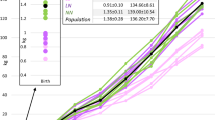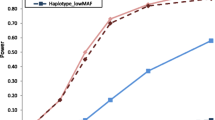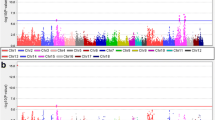Abstract
A total of 312 boars (201 Landrace and 111 Large White) were genotyped with a custom-made low throughput genotyping microarray (called SNiPORK) based on array primer extension (APEX) technology. The results were used to association studies between genotyped SNP markers and daily gains, meat content and selection index. Among the 60 SNP markers analyzed, 14 of them showed statistically significant associations between the genotype and the level of at least one trait. In order to find extremely beneficial or unfavorable intergenic diplotype combinations, 5 SNP markers were selected: CAST A499C, MYF6 T255C, PKLR C384T, SFRS1 C1146T and TNNT3 T153C, which showed statistically significant associations at P ≤ 0.01 within one of the traits and the frequency of homozygotes with a minor allele of at least 0.1. Among 10 possible permutations, statistically significant associations were found only for a combination of SNP markers in TNNT3 × SFRS1 genes and, interestingly, for all combinations with SNP located within the calpastatin (CAST) gene commonly known as a gene influencing pork quality traits. This study also found that CAST allele A (which is beneficial for pork tenderness) is also favorable for growth rate. This effect is clearly increased with additive alleles C of myogenic factor MYF6 and troponin T3 (TNNT3) and is decreased with each allele T from serine rich splicing factor 1 (SFRS1) gene. For meat content, the most favorable genotype of calpastatin gene was AC, the effect of which was generally increased with each C allele of MYF6 and TNNT3 and decreased with each allele T from SFRS1 and PKLR (puruvate kinase) genes, respectively. The calpastatin AC genotype seemed to be beneficial for selection index, although in combination with the CC genotype of troponin T3, calpastatin genotypes AA and CC reached higher values. In the case of the combination of genotypes TNNT3 × SFRS1, the most preferable for all analyzed traits is the CC genotype of TNNT3, especially in combination with CT or CC genotypes in the SFRS1 gene. We conclude that searching for interaction effects between candidate SNPs (even of moderate influence) may lead to interesting and valuable findings enabled better understanding and applications of SNPs in pork yield and quality improvement programmes.
Similar content being viewed by others
References
Fujii, J., Otsu, K., Zorzato, F., et al., Identification of a Mutation in Porcine Ryanodine Receptor Associated with Malignant Hyperthermia, Science, 1991, vol. 253, pp. 448–451.
Van Laere, A.S., Nguyen, M., Braunschweig, M., et al., A Regulatory Mutation in IGF2 Causes a Major QTL Effect on Muscle Growth in the Pig, Nature, 2003, vol. 425, pp. 832–836.
Grindflek, E., Holzbauer, R., Plastow, G.S., and Rothschild, M.F., Mapping and Investigation of the Porcine Major Insulin Sensitive Glucose Transport (SLC2A4/GLUT4) Gene as a Candidate Gene for Meat Quality and Carcass Traits, J. Anim. Breed. Genet., 2002, vol. 119, pp. 47–55.
Stefanon, B., Floris, R., Braglia, S., et al., A New Approach in Association Study of Single Nucleotide Polymorphism of Genes for Carcass and Meat Quality Traits in Commercial Pigs, Ital. J. Anim. Sci., 2004, vol. 3, pp. 177–189.
Russo, V., Fontanesi, L., Davoli, R., et al., Analysis of Single Nucleotide Polymorphisms in Major and Candidate Genes for Production Traits in Nero Siciliano Pig Breed, Ital. J. Anim. Sci., 2004, vol. 3, pp. 19–29.
Kamin-ski, S., Help, H., Brym, P., et al., SNiPORK a Microarray of SNPs in Candidate Genes Potentially Associated with Pork Yield and Quality Development and Validation in Commercial Breeds, Anim. Biotechnol., 2008, vol. 19, pp. 43–69.
Kurg, A., Tonisson, N., Georgiou, I., et al., Arrayed Primer Extension: Solid-Phase Four-Color DNA Resequencing and Mutation Detection Technology, Genet. Test, 2000, vol. 4, pp. 1–7.
Brym, P. and Kamiński, S., Database of SNPs in Candidate Genes Potentially Associated with Yield and Quality of Pork, Anim. Sci. Papers Rep., 2006, vol. 24, pp. 239–257.
Wyszyńska-Koko, J., Pierzcha a, M., and Flisikowski, K., et al., Polymorphism in Coding and Regulatory Regions of the Porcine MYF6 and MYOG Genes and Expression of the MYF6 Gene in m. longissimus dorsii versus Productive Traits in Pigs, J. Appl. Genet., 2006, vol. 47, pp. 131–138.
Amills, M., Vidal, O., Varona, L., et al., Polymorphism of the Pig 2.4-Dienoyl CoA Reductase 1 Gene (DECR1) and Its Association with Carcass and Meat Quality Traits, J. Anim. Sci., 2005, vol. 83, pp. 493–498.
Ciobanu, D.C., Bastiaansen, J.W.M., Lonergan, S.M., et al., New Alleles in Calpastatin Gene Are Associated with Meat Quality Traits in Pigs, J. Anim. Sci., 2004, vol. 82, pp. 2829–2839.
Meyers, S.N. and Beever, J.E., Investigating the Genetic Basis of Pork Tenderness: Genomic Analysis of Porcine CAST, Anim. Genet., 2008, vol. 39, pp. 531–543.
Barnoy, S., Glaser, T., and Kosower, N.S., The Role of Calpastatin in Myoblast Differentiation and Fusion, Biochem. Biophys. Res. Commun., 1996, vol. 220, no. 3, pp. 933–938.
Kretchmer, D.H., Koohmaraie, M., and Mersmann, H.J., Comparison of Proteolytic Variables in a Lean and Obese Strain of Pig at the Ages of 2.5 and 7 Months, Lab. Anim. Sci., 1994, vol. 44, pp. 38–41.
Koćwin-Podsiadła, M., Kuryk, J., Krzecio, E., et al., The Interaction between Calpastatin and RYR1 Genes for Some Pork Quality Traits, Meat Sci., 2003, vol. 65, pp. 731–735.
Krzęcio, E., Kocćwin-Podsiadła, M., Kuryk, J., et al., The Effect of Interaction between Genotype CAST/RsaI (Calpastatin) and MYOG/MspI (Myogenin) on Carcass and Meat Quality in Pigs Free of RYR1T Allele, Meat Sci., 2008, vol. 80, pp. 1106–1115.
Goddard, M.E. and Hayes, B.J., Genomic Selection, J. Anim. Breed. Genet., 2007, vol. 124, pp. 323–330.
Author information
Authors and Affiliations
Corresponding author
Additional information
Published in Russian in Genetika, 2011, Vol. 47, No. 5, pp. 651–659.
The article was translated by the authors.
Rights and permissions
About this article
Cite this article
Brym, P., Sazanov, A.A. & Kaminski, S. Associations between 60 SNPs identified by APEX microarray and growth rate, meatiness and selection index in boars. Russ J Genet 47, 571–578 (2011). https://doi.org/10.1134/S1022795411050024
Received:
Published:
Issue Date:
DOI: https://doi.org/10.1134/S1022795411050024




